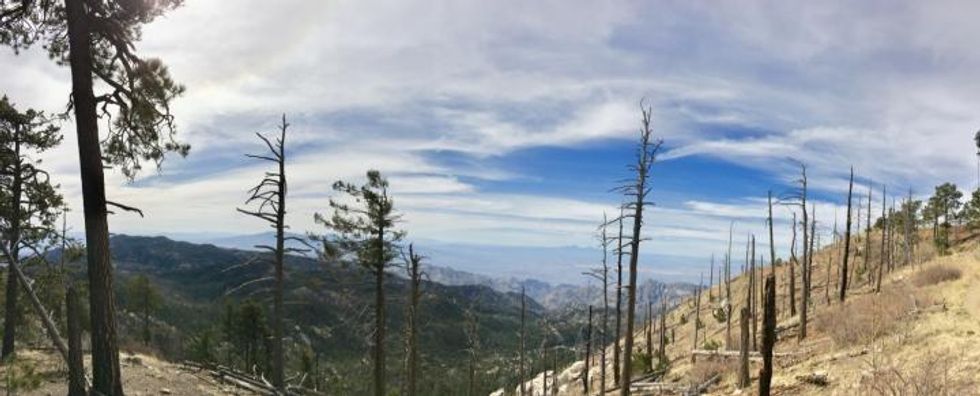

SUBSCRIBE TO OUR FREE NEWSLETTER
Daily news & progressive opinion—funded by the people, not the corporations—delivered straight to your inbox.
5
#000000
#FFFFFF
To donate by check, phone, or other method, see our More Ways to Give page.


Daily news & progressive opinion—funded by the people, not the corporations—delivered straight to your inbox.

A sign on a farm trailer reading "Food grows where water flows" hangs over dry, cracked mud at the edge of a farm April 16, 2009 near Buttonwillow, California. (Photo: David McNew/Getty Images)
The western United States is likely being gripped by an "emerging" megadrought partly fueled by the climate crisis, says a study published Friday.
Researchers claim the region's 19-year drought, from 2000-2018, already rivals that of any over the past 1,200 years.
"We're no longer looking at projections, but at where we are now," said lead author Park Williams, a bioclimatologist at Columbia University's Lamont-Doherty Earth Observatory, in a statement. "We now have enough observations of current drought and tree-ring records of past drought to say that we're on the same trajectory as the worst prehistoric droughts."
For the study, published in the journal Science, Williams and the other researchers looked at nine U.S. states, stretching from Oregon and Montana at the northern and southward through California and New Mexico. The researchers also included a portion of northern Mexico in the study.
\u201cClimate-Driven Megadrought Is Emerging in Western U.S., Says Study\nWarming May Be Triggering Era Worse Than Any in Recorded History\nhttps://t.co/xzZjHcKt8r\u201d— Columbia Climate School (@Columbia Climate School) 1587070663
Using tree ring data to infer yearly soil moisture and plot out the pre-modern data, the researchers documented four megadroughts--multi-decade droughts--beginning in 800 AD.
The southwest's current drought was worse compared to the ones that took place in the late 800s, mid-1100s, and the 1200s. The most severe megadrought on recorrd began in 1575, though researchers said the difference between that Medieval one and the current was slight.
And while natural variability played a role in the current drought, the scientists estimate about half the blame--47%--lies with the Earth's heating, as warmer air is able to suck up more ground moisture.

Natural variability that can drive drought will likely continue, as will global warming, threatening further upheaval for a region already facing groundwater depletion.
"Because the background is getting warmer, the dice are increasingly loaded toward longer and more severe droughts," added Williams.
"We may get lucky, and natural variability will bring more precipitation for a while," he said. "But going forward, we'll need more and more good luck to break out of drought, and less and less bad luck to go back into drought."
Dear Common Dreams reader, The U.S. is on a fast track to authoritarianism like nothing I've ever seen. Meanwhile, corporate news outlets are utterly capitulating to Trump, twisting their coverage to avoid drawing his ire while lining up to stuff cash in his pockets. That's why I believe that Common Dreams is doing the best and most consequential reporting that we've ever done. Our small but mighty team is a progressive reporting powerhouse, covering the news every day that the corporate media never will. Our mission has always been simple: To inform. To inspire. And to ignite change for the common good. Now here's the key piece that I want all our readers to understand: None of this would be possible without your financial support. That's not just some fundraising cliche. It's the absolute and literal truth. We don't accept corporate advertising and never will. We don't have a paywall because we don't think people should be blocked from critical news based on their ability to pay. Everything we do is funded by the donations of readers like you. Will you donate now to help power the nonprofit, independent reporting of Common Dreams? Thank you for being a vital member of our community. Together, we can keep independent journalism alive when it’s needed most. - Craig Brown, Co-founder |
The western United States is likely being gripped by an "emerging" megadrought partly fueled by the climate crisis, says a study published Friday.
Researchers claim the region's 19-year drought, from 2000-2018, already rivals that of any over the past 1,200 years.
"We're no longer looking at projections, but at where we are now," said lead author Park Williams, a bioclimatologist at Columbia University's Lamont-Doherty Earth Observatory, in a statement. "We now have enough observations of current drought and tree-ring records of past drought to say that we're on the same trajectory as the worst prehistoric droughts."
For the study, published in the journal Science, Williams and the other researchers looked at nine U.S. states, stretching from Oregon and Montana at the northern and southward through California and New Mexico. The researchers also included a portion of northern Mexico in the study.
\u201cClimate-Driven Megadrought Is Emerging in Western U.S., Says Study\nWarming May Be Triggering Era Worse Than Any in Recorded History\nhttps://t.co/xzZjHcKt8r\u201d— Columbia Climate School (@Columbia Climate School) 1587070663
Using tree ring data to infer yearly soil moisture and plot out the pre-modern data, the researchers documented four megadroughts--multi-decade droughts--beginning in 800 AD.
The southwest's current drought was worse compared to the ones that took place in the late 800s, mid-1100s, and the 1200s. The most severe megadrought on recorrd began in 1575, though researchers said the difference between that Medieval one and the current was slight.
And while natural variability played a role in the current drought, the scientists estimate about half the blame--47%--lies with the Earth's heating, as warmer air is able to suck up more ground moisture.

Natural variability that can drive drought will likely continue, as will global warming, threatening further upheaval for a region already facing groundwater depletion.
"Because the background is getting warmer, the dice are increasingly loaded toward longer and more severe droughts," added Williams.
"We may get lucky, and natural variability will bring more precipitation for a while," he said. "But going forward, we'll need more and more good luck to break out of drought, and less and less bad luck to go back into drought."
The western United States is likely being gripped by an "emerging" megadrought partly fueled by the climate crisis, says a study published Friday.
Researchers claim the region's 19-year drought, from 2000-2018, already rivals that of any over the past 1,200 years.
"We're no longer looking at projections, but at where we are now," said lead author Park Williams, a bioclimatologist at Columbia University's Lamont-Doherty Earth Observatory, in a statement. "We now have enough observations of current drought and tree-ring records of past drought to say that we're on the same trajectory as the worst prehistoric droughts."
For the study, published in the journal Science, Williams and the other researchers looked at nine U.S. states, stretching from Oregon and Montana at the northern and southward through California and New Mexico. The researchers also included a portion of northern Mexico in the study.
\u201cClimate-Driven Megadrought Is Emerging in Western U.S., Says Study\nWarming May Be Triggering Era Worse Than Any in Recorded History\nhttps://t.co/xzZjHcKt8r\u201d— Columbia Climate School (@Columbia Climate School) 1587070663
Using tree ring data to infer yearly soil moisture and plot out the pre-modern data, the researchers documented four megadroughts--multi-decade droughts--beginning in 800 AD.
The southwest's current drought was worse compared to the ones that took place in the late 800s, mid-1100s, and the 1200s. The most severe megadrought on recorrd began in 1575, though researchers said the difference between that Medieval one and the current was slight.
And while natural variability played a role in the current drought, the scientists estimate about half the blame--47%--lies with the Earth's heating, as warmer air is able to suck up more ground moisture.

Natural variability that can drive drought will likely continue, as will global warming, threatening further upheaval for a region already facing groundwater depletion.
"Because the background is getting warmer, the dice are increasingly loaded toward longer and more severe droughts," added Williams.
"We may get lucky, and natural variability will bring more precipitation for a while," he said. "But going forward, we'll need more and more good luck to break out of drought, and less and less bad luck to go back into drought."